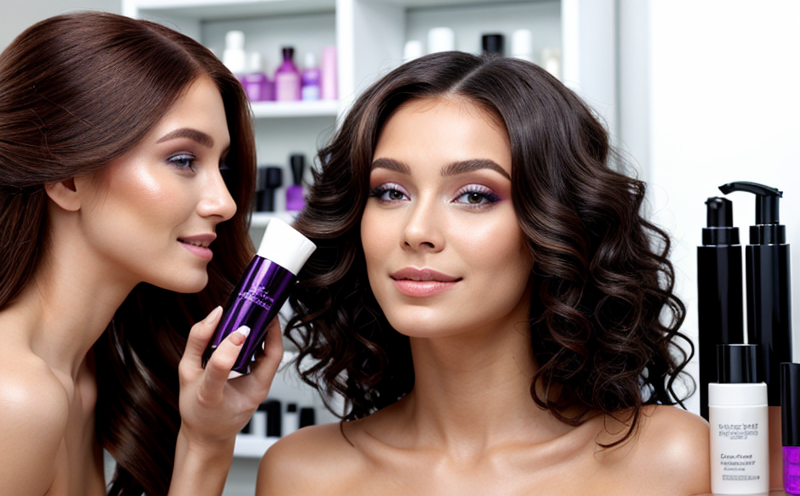Hair Shine Measurement Testing in Hair Care Products
The measurement of hair shine is an essential component of cosmetic testing, particularly within the realm of hair care products. This test assesses how effectively a product enhances the natural luster and appearance of hair, thereby influencing consumer satisfaction and brand reputation. The importance of this metric is underscored by its role in differentiating high-quality products from substandard ones.
For quality managers, compliance officers, R&D engineers, and procurement professionals involved in the development and regulation of cosmetic products, understanding how to measure shine can be crucial for ensuring product performance meets market expectations. Hair shine testing involves a series of standardized procedures that are designed to quantify the reflective properties of hair treated with specific formulations.
The first step in this process is selecting the appropriate specimens for analysis. These could include human hair samples or synthetic fibers, depending on the intended use of the product. Specimens must be prepared according to specified protocols to ensure consistency and comparability across tests.
Once prepared, the specimens undergo a series of treatments designed to simulate real-world usage conditions. This might involve exposing the samples to various environmental factors such as humidity or temperature fluctuations, which can affect how they respond to different products.
The heart of the hair shine measurement process lies in the instrumentation used to capture reflective properties accurately. Various devices are employed for this purpose, including spectrophotometers tailored specifically for measuring specular reflectance from surfaces like human hair strands. These instruments provide precise readings that help researchers understand the effectiveness of their formulations better.
After obtaining initial measurements, it's important to compare these results against established standards or benchmarks set by industry bodies such as ISO (International Organization for Standardization) or ASTM International. Compliance with these guidelines ensures that your product meets international quality thresholds and is suitable for global markets.
Furthermore, continuous monitoring of hair shine performance during the product lifecycle helps identify any potential issues early on. This proactive approach allows manufacturers to make necessary adjustments before launching their products into the market, ensuring consistent excellence throughout production runs.
In summary, hair shine measurement testing plays a vital role in enhancing customer experience by optimizing cosmetic formulations aimed at improving hair appearance. By adhering to rigorous scientific methods and leveraging advanced analytical tools, laboratories can deliver reliable data that supports informed decision-making processes within the industry.
International Acceptance and Recognition
The International Organization for Standardization (ISO) provides global standards that many countries adopt as national standards, ensuring consistent quality across borders.
American Society for Testing and Materials (ASTM) offers specific protocols relevant to the cosmetic industry, which are widely respected by both domestic and international stakeholders.
European Norms (EN), particularly those related to personal care products, offer additional depth in terms of regulatory compliance.
The International Electrotechnical Commission (IEC) sets standards for electrical safety, which indirectly influence the design and functionality of hair care appliances like dryers or straighteners.
By adhering to these international norms, manufacturers demonstrate their commitment to excellence and reliability, thereby gaining competitive advantages in global markets.
Competitive Advantage and Market Impact
Accurate hair shine measurement testing provides valuable insights that can significantly enhance the competitiveness of a cosmetic product. By providing measurable evidence of improved appearance, companies can differentiate their offerings from competitors more effectively. This differentiation not only attracts discerning consumers but also fosters brand loyalty.
In addition to enhancing consumer appeal, robust hair shine testing supports innovation within the industry. It allows R&D teams to experiment with new ingredients and formulations confidently, knowing they have reliable metrics against which to evaluate success. Such advancements contribute to a richer variety of products available globally.
Moreover, compliance with international standards opens doors for broader market access. Many countries require imported goods to meet certain quality criteria set by their respective regulatory bodies. Meeting these requirements not only avoids potential barriers but also signals to buyers that the product is trustworthy and safe.
The ability to consistently achieve superior hair shine results translates directly into increased sales volumes and customer satisfaction scores. Happy customers are more likely to recommend products positively, driving word-of-mouth marketing efforts which further boost brand reputation.
Use Cases and Application Examples
Hair shine measurement testing finds application in various stages of product development and quality control. During early-stage R&D, this test serves as a diagnostic tool to identify promising new ingredients or combinations that enhance hair appearance effectively.
In later stages, it becomes an integral part of final validation processes where manufacturers verify whether their products deliver the expected benefits consistently across different batches or environments.
Another key application is in post-launch monitoring. Companies use this technique to track long-term trends and identify any degradation in product performance over time. Such information guides corrective actions needed to maintain high standards continuously.
A case study involving a leading shampoo brand illustrates the benefits of thorough hair shine measurement testing. Before launching their latest formula, they conducted extensive trials using spectrophotometric methods. Their rigorous approach revealed subtle yet significant improvements that were not evident through visual inspection alone.





